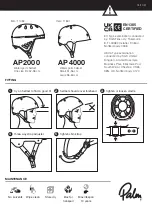
VRLA BATTERIES
AUGUST 2003
This information is generally descriptive only and is not intended to make or imply any representation, guarantee or warranty with respect to any cells and batteries. Cell and battery designs/specifications are subject
to modification without notice. Contact Panasonic for the latest information.
PRECAUTIONS FOR HANDLING VALVE-REGULATED LEAD-ACID BATTERIES-
CONT.
RECOMMENDATION
(1) The recommended cut-off voltage during
discharge depends on the size of the discharge
current. The relationship between the storage
battery discharge current and the ideal discharge
cut-off voltage is described in Panasonic
specifications and technical handbooks.
Do not continue discharging to the point where
the voltage drops below the recommended
discharge cut-off voltage.
If a storage battery that was discharged below
the recommended discharge cut-off voltage is
recharged, the storage battery may generate heat
which could deform it or cause condensation to
form on the battery casing due to the evaporation
of moisture from inside the battery. Discharging
below the recommended discharge cut-off
voltage may also accelerate the deterioration of
the battery’s performance characteristics.
(2) Avoid overdischarge, and charge the battery
immediately after discharge. The instruction
manual of the equipment should contain informa-
tion telling the user not to overdischarge the
battery and to charge the battery immediately
after the use of the equipment (discharge). Even
if discharge of the battery is stopped before
voltage decreases to such a level that the battery-
driven equipment stops being operational, dete-
rioration of the battery may be accelerated by the
so-called sulphation phenomenon if it is not
recharged after use. The low voltage cut-off
circuit should be designed so that it can com-
pletely cut off the discharge current including a
weak current.
(3) If a charge method and a charge condition other
than that described in the specification and the
technical brochures is to be adopted, charge/
discharge characteristics and life characteristics
of the battery should be thoroughly checked in
advance. The adoption of adequate charge
methods and adequate charge conditions are
crucial to ensure safe use of the battery and for
fully utilizing the battery capacity.
(4) For the cycle operation of the battery (application
of the battery as the main source of power by
repeating charge and discharge), use a charger
which operates by controlling either the charge
period or charge quantity. Continue charging the
battery for the time specified or until the charge
completion lamp, if provided, indicates completion
of charge. If charging is suspended before
completion, the service life of the battery may be
shortened.
(5) Avoid parallel charging of batteries in cycle use,
as this may shorten the service life of the batter-
ies by causing an imbalance in charge/discharge
state among the batteries connected in parallel.
(6) During trickle or float charge of the battery,
measure the total voltage with a high-accuracy
voltmeter of Class 0.5 or better. If the voltage
readout does not meet the specified value,
investigate the reason and take proper measures.
A total voltage that is lower than the specified
value indicates insufficient charge which may
reduce the battery capacity; a voltage higher than
specified indicates an overcharge which may
shorten service life of the battery or cause
problems such as thermal runaway in some
cases.
(7) Make sure to turn off the switch of the battery
equipment after use, otherwise excessive
discharge may cause deterioration in battery
performance and shorten service life.
(8) When the equipment is not used for a long period,
remove the battery from the equipment, charge it
fully, and store it in a place where humidity is low.
Unsatisfactory storage conditions may cause
deterioration in battery performance, shorten
service life and could cause rust to form on the
terminals.



























